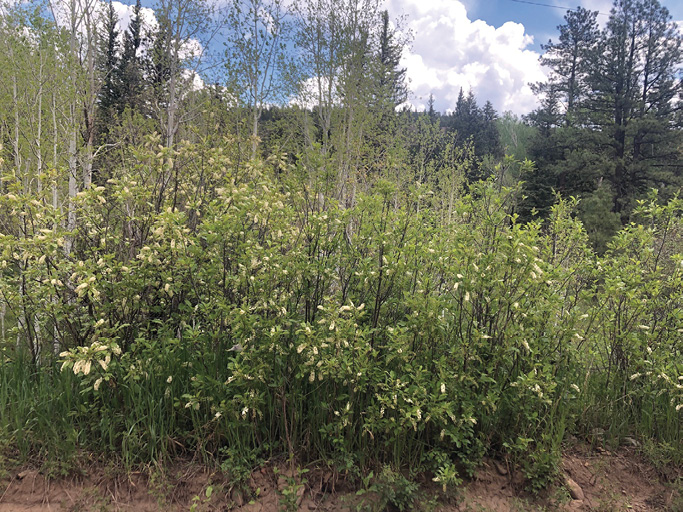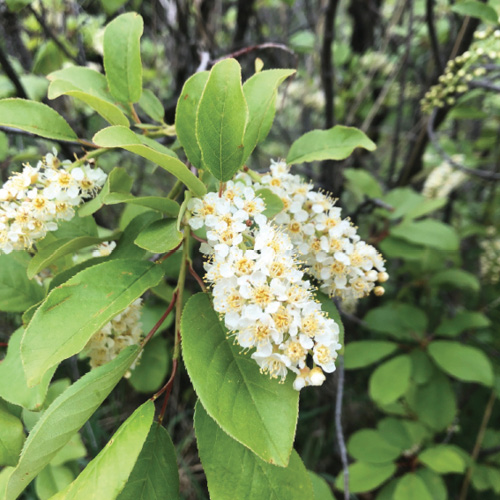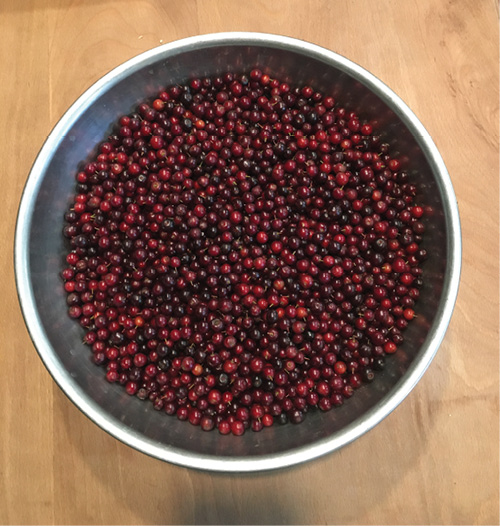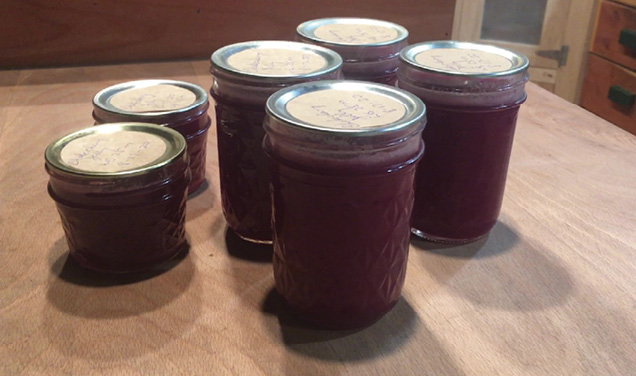Guide H-339
Suzanne DeVos-Cole
College of Agricultural, Consumer and Environmental Sciences, New Mexico State University
Author: County Program Director/Extension Agriculture Agent, Mora County Extension Office, New Mexico State University. (Print Friendly PDF)
Introduction
Chokecherries are found throughout New Mexico. Historically, the berries were used as a source of food by Native Americans and settlers, while many parts of the shrub were used for medicinal purposes. Today, the fruit from this wild shrub ( Prunus virginiana ) is still used to make jelly, and the plants are a great landscape option. The name chokecherry is derived from the berries, which when eaten raw have an astringent, bitter taste similar to tannins in tea. This causes the mouth to pucker, thus giving the fruit its name. This astringency is due to the hydrocyanic acid (cyanide) present in all members of the Prunus genus, and specifically in the seeds, leaves, and stems of chokecherries.
The plants are native to North America and are found throughout the continent, with the exception of the Southeastern region of the United States. The species Prunus virginia has two subspecies present in New Mexico— Prunus virginiana var. demissa , western chokecherry, which is found throughout the state; and Prunus virginiana var. melanocarpa , black chokecherry, which is found in the northern, eastern, and central parts of the state. To see which are growing in your county, visit https://plants.usda.gov/. There are ornamental cultivars, such as ‘Canada Red’ and ‘Shubert’, specifically bred to be non-suckering, with larger edible fruit and colorful fall foliage. In researching the different subspecies found in New Mexico, there does not seem to be a consensus on the nomenclature for the varieties; this guide uses the information provided by the U.S. Department of Agriculture PLANTS database ( https://plants.usda.gov/). Bolded terms are defined in the glossary at the end of this guide.
Uses
Chokecherries are used to make juice, jelly, syrup, wine, pies, and medicines. The shrub’s inner bark is used for medicinal purposes such as cough syrups and sedatives. In addition to being a source of fiber and antioxidants, chokecherry fruits are also high in nutrients, including manganese, potassium, and vitamins C, K, and B6. A half-cup of berries has about 156 calories. Historically, Native Americans used the berries for health and food. The dried berries were used in pemmican—a mixture of dried meat, fruit, and fat. The berries were also cooked to create juice and pastes, which were used to help with respiratory and digestive issues. Both preparation methods break down and neutralize the hydrocyanic acid stored in the pits.
Plant Description
Chokecherries are members of the Rosaceae (rose) family. They grow in USDA hardiness zones 2 to 7. Chokecherries prefer sun, are adaptable to a variety of soils, and are drought-tolerant. They will form thick stands if they are happy with their growing conditions. They have a lifespan of about 25 years. Chokecherries can be grown as a tree or a shrub and can reach a height of 30 feet, though they are most commonly 20 feet or less (Figure 1). They prefer an “edge” habitat and are often found along stream banks, roadsides, or the edges of fields and woods. Chokecherries have rhizome roots extending beyond the dripline , thus prompting suckers .

Figure 1. Chokecherries growing in the wild are typically shrubs less than 20 feet tall.
This species is unusual in that its physical appearance changes based on its location. For example, the foliage shape can range from a longer oval shape to a round or fat one, and the color can range from a bright glossy green to a dull darker green. All leaves have a finely toothed edge and turn yellow or red in autumn. Their white flowers with yellow centers grow on racemes that are 3 to 6 inches long (Figure 2), appearing just after the foliage emerges, usually in April or May depending on location and altitude. The fragrant flowers attract bees, butterflies, and other insects. The fruits ripen about three months after the flowers appear and are foraged by birds and wildlife. All parts of the plant EXCEPT the meaty part of the fruit are poisonous—this includes the leaves, stems, and fruit pits. The plant contains hydrocyanic acid (also known as prussic acid), which can be fatal if ingested in large quantities. This acid increases in the plant when they are stressed by drought or frost. Chokecherries are listed as a plant poisonous to livestock, and fresh or wilted foliage can be fatal to them.

Figure 2. Chokecherry flowers grow on structures called racemes.
Harvesting
Harvest usually occurs in late summer or early fall. When harvesting, wear long sleeves to protect yourself from branches and mosquitos. Gloves can be worn to avoid staining the skin; however, berries are easier to handle with bare fingers. Be aware of bears and other wildlife because chokecherries are a favorite source of food in the fall. The berries grow in clustered panicles (Figure 3), which separate easily when ripe. For best flavor, pick berries when they are dark red or purple. The addition of some lighter-colored (unripe) berries will add pectin .

Figure 3. Chokecherry berries grow in loose clusters called panicles, which separate easily when ripe.
Chokecherry Jelly Basics
Jelly is made from the juice collected from berries. Sort through the collected berries and remove any debris, leaves, and rotten or spoiled berries. Only use fruit free of blemishes or fungus. A spoiled berry can ruin a whole batch of juice or jelly, wasting your time and effort. Rinse the berries after sorting. Berries can be frozen at this point for future use (Figure 4). Frozen berries can be used for jelly, wine, syrups, juice, vinegar, and pies. To freeze berries, pat them dry and place them on a baking sheet or tray lined with parchment paper, leaving space between each berry. Place trays in the freezer for a minimum of four hours. Transfer frozen berries from trays to freezer-safe containers or bags. Label the bags with the freezing date before returning packaged fruit to the freezer. The berries can be kept in the freezer for up to two years as long as freezer-grade bags or containers are used.

Figure 4. Sorted and cleaned chokecherries can be frozen for up to two years.
You will need the following equipment for making juice and jellies:
- Wooden mixing spoons
- Ladle
- 8-quart heavyweight cooking pot
- Tongs
- Measuring cup and spoon sets
- 6 half-pint canning jars, with canning lids and screw bands
- Pot holders
- Paper towels
- Cloth towels
- Large colander
- Cheesecloth
- Canning set
- Jar lifter
- Magnetized lid lifter
- Funnel
- Boiling water canner with rack
Making juice from chokecherries and apples
To make the chokecherry liquid or juice, put whole berries (fresh or frozen) in a stockpot. Whole chokecherries should not be blended or crushed because their seeds contain toxins. Chokecherries contain some pectin, but not enough to promote proper gelling. You will need to add commercial pectin or apples to add enough pectin to create a gel point. If using commercial pectin, follow the directions on the packaging (see Chokecherry jelly with added pectin recipe below). If using apples, add 1.5 pounds of apples (about 6 medium-sized apples of any variety, cut in half) to 2.5 pounds of berries in a heavyweight pot. Cover with just enough water to submerge fruit. Bring to a boil and simmer until the berries soften and begin to fall apart, about 15 minutes. Do not overcook at this stage since it could lower the ability of the natural pectin to gel.
Pour the liquid and fruit mixture into a colander lined with a damp cheesecloth—this will ensure the cheesecloth does not absorb any of the precious chokecherry juice. Let the bag drain for at least four hours, or allow to drain overnight in the refrigerator. Do not wring the bag or press on the chokecherries, otherwise the jelly will not be clear. Discard berries, apples, and cheesecloth. Measure the accumulated liquid; 2.5 pounds or 19 cups of berries should yield about 8 cups of juice. The juice can be frozen at this point. Make sure to follow the recipe carefully. Do not make a double batch because the proportions will not allow the juice to gel.
These recipes are intended for individuals with a basic understanding of canning procedures. For more detailed information, consult the USDA Complete Guide to Home Canning (2015), which is available online at https://nchfp.uga.edu/publications/publications_usda.html or through your local county Cooperative Extension Service office ( https://aces.nmsu.edu/county/). For general jelly-making procedures and altitude adjustments for canning processing times, see NMSU Extension Guide E-314, Making Jam, Jelly, and Sweet Spreads at Home ( https://pubs.nmsu.edu/_e/E314/index.html).
Recipes
Chokecherry jelly with apples
Yields 6 half-pint jars
Ingredients
- 6 cups chokecherry juice from chokecherries and apples (see procedure above)
- 6 cups sugar
Combine juice and sugar in a non-reactive, heavyweight pot. Heat over medium heat and bring to a boil, stirring occasionally. Boil uncovered until it reaches a gel point (see Guide E-314); this can take up to half an hour. Remove from heat. Use a funnel to fill jars, leaving a 1/4-inch headspace. Add lids and bands and seal jars. Place jars on a rack in a water bath canner—never place jars directly on the bottom of the canner. Make sure the water is at least 2 inches above the top of the jars. Bring water to a boil and process for the correct time according to your elevation. After processing, carefully remove jars using a jar lifter. Allow jars to cool for 12 to 24 hours before removing lid bands (Figure 5) and testing for lid seal (see Guide E-314).

Figure 5. Processed and labeled jars of chokecherry jelly ready for storage.
Chokecherry jelly with added pectin
Yields 6 half-pint jars
Ingredients
- 6 cups chokecherry juice
- 6 cups sugar
- Pectin, dry or liquid (amount according to the package)
Add juice and sugar to a non-reactive, heavyweight pot. Bring to a simmer, then add pectin. Bring to a boil. Lower heat and cook, stirring frequently. Check for gelling after 5 minutes. For estimated cooking times to reach gel point, check the instructions on the pectin package. Once the liquid has gelled, turn off the heat. Use a funnel to fill jars, leaving a 1/4-inch headspace. Add lids and bands and seal jars. Place jars on a rack in a water bath canner—never place jars directly on the bottom of the canner. Make sure the water is at least 2 inches above the top of the jars. Bring water to a boil and process for the correct time according to your elevation. After processing, carefully remove jars using a jar lifter. Allow jars to cool for 12 to 24 hours before removing lid bands and testing for lid seal (see Guide E-314).
Additional NMSU Extension Resources
Guide E-314: Making Jam, Jelly, and Sweet Spreads at Home
https://pubs.nmsu.edu/_e/E314/index.html
Guide E-215: High-Altitude Cooking
https://pubs.nmsu.edu/_e/E215/index.html
Glossary
Dripline: The outer edge of a tree’s canopy.
Hydrocyanic acid: A highly poisonous acidic solution of hydrogen cyanide in water.
Panicle: A compound raceme in which the branches of the raceme are themselves racemes.
Pectin: A soluble, gelatinous polysaccharide that is present in ripe fruits and is extracted for use as a gelling agent in jams and jellies.
Prunus virginiana : Scientific name for the chokecherry plant. Prunus , Latin for plum tree; virginiana , Latin for virgin or unworked land.
Raceme: A flower cluster with the separate flowers attached by short, equal stalks at equal distances along a central stem. The flowers at the base of the central stem develop first.
Rhizome: A modified underground plant stem that produces roots and shoots.
Suckers: Vegetative growth structures that emerge from a tree’s root system.
For further reading
H-320: Raspberries for the Home Garden
https://pubs.nmsu.edu/_h/H320/index.html
H-326: Minor Small Fruit Crops for New Mexico Gardens
https://pubs.nmsu.edu/_h/H326/index.html
H-327: Pruning the Home Orchard
https://pubs.nmsu.edu/_h/H327/index.html

Suzanne DeVos-Cole is an Extension Agent for Mora County at New Mexico State University. She received her MLA from the University of Pennsylvania in landscape architecture. Her Extension program focuses on improving the quality of life for her constituents in the areas of 4-H and youth development, agriculture, and family and consumer sciences.
To find more resources for your business, home, or family, visit the College of Agricultural, Consumer and Environmental Sciences on the World Wide Web at pubs.nmsu.edu.
Contents of publications may be freely reproduced, with an appropriate citation, for educational purposes. All other rights reserved. For permission to use publications for other purposes, contact pubs@nmsu.edu or the authors listed on the publication.
New Mexico State University is an equal opportunity/affirmative action employer and educator. NMSU and the U.S. Department of Agriculture cooperating.
December 2022 Las Cruces, NM


